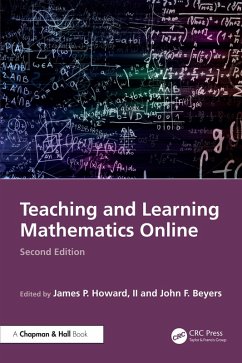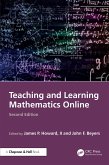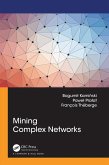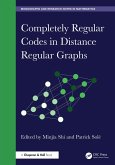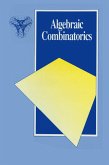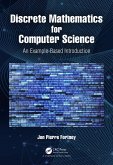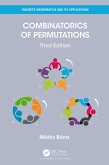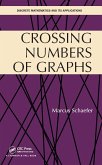Teaching and Learning Mathematics Online (eBook, ePUB)
Redaktion: Howard II, James P.; Beyers, John F.


Alle Infos zum eBook verschenken

Teaching and Learning Mathematics Online (eBook, ePUB)
Redaktion: Howard II, James P.; Beyers, John F.
- Format: ePub
- Merkliste
- Auf die Merkliste
- Bewerten Bewerten
- Teilen
- Produkt teilen
- Produkterinnerung
- Produkterinnerung

Hier können Sie sich einloggen

Bitte loggen Sie sich zunächst in Ihr Kundenkonto ein oder registrieren Sie sich bei bücher.de, um das eBook-Abo tolino select nutzen zu können.
Teaching and Learning Mathematics Online, Second Edition continues to present meaningful and practical solutions for teaching mathematics and statistics online. It focuses on the problems observed by mathematics instructors currently working in the field who strive to hone their craft and share best practices with the community. The book provides a set of standard practices, improving the quality of online teaching and the learning of mathematics. Instructors will benefit from learning new techniques and approaches to delivering content.
New to the Second Edition
Nine brand new…mehr
- Geräte: eReader
- mit Kopierschutz
- eBook Hilfe
- Größe: 11.13MB
![Teaching and Learning Mathematics Online (eBook, PDF) Teaching and Learning Mathematics Online (eBook, PDF)]() Teaching and Learning Mathematics Online (eBook, PDF)53,95 €
Teaching and Learning Mathematics Online (eBook, PDF)53,95 €![Mining Complex Networks (eBook, ePUB) Mining Complex Networks (eBook, ePUB)]() Bogumil KaminskiMining Complex Networks (eBook, ePUB)56,95 €
Bogumil KaminskiMining Complex Networks (eBook, ePUB)56,95 €![Completely Regular Codes in Distance Regular Graphs (eBook, ePUB) Completely Regular Codes in Distance Regular Graphs (eBook, ePUB)]() Completely Regular Codes in Distance Regular Graphs (eBook, ePUB)162,95 €
Completely Regular Codes in Distance Regular Graphs (eBook, ePUB)162,95 €![Algebraic Combinatorics (eBook, ePUB) Algebraic Combinatorics (eBook, ePUB)]() Chris GodsilAlgebraic Combinatorics (eBook, ePUB)177,95 €
Chris GodsilAlgebraic Combinatorics (eBook, ePUB)177,95 €![Discrete Mathematics for Computer Science (eBook, ePUB) Discrete Mathematics for Computer Science (eBook, ePUB)]() Jon Pierre FortneyDiscrete Mathematics for Computer Science (eBook, ePUB)52,95 €
Jon Pierre FortneyDiscrete Mathematics for Computer Science (eBook, ePUB)52,95 €![Combinatorics of Permutations (eBook, ePUB) Combinatorics of Permutations (eBook, ePUB)]() Miklos BonaCombinatorics of Permutations (eBook, ePUB)56,95 €
Miklos BonaCombinatorics of Permutations (eBook, ePUB)56,95 €![Crossing Numbers of Graphs (eBook, ePUB) Crossing Numbers of Graphs (eBook, ePUB)]() Marcus SchaeferCrossing Numbers of Graphs (eBook, ePUB)45,95 €
Marcus SchaeferCrossing Numbers of Graphs (eBook, ePUB)45,95 €-
-
-
New to the Second Edition
- Nine brand new chapters
- Reflections on the lessons of COVID-19
- Explorations of new technological opportunities
Dieser Download kann aus rechtlichen Gründen nur mit Rechnungsadresse in A, B, BG, CY, CZ, D, DK, EW, E, FIN, F, GR, HR, H, IRL, I, LT, L, LR, M, NL, PL, P, R, S, SLO, SK ausgeliefert werden.
- Produktdetails
- Verlag: Taylor & Francis eBooks
- Seitenzahl: 696
- Erscheinungstermin: 30. Juni 2025
- Englisch
- ISBN-13: 9781040337578
- Artikelnr.: 74400284
- Verlag: Taylor & Francis eBooks
- Seitenzahl: 696
- Erscheinungstermin: 30. Juni 2025
- Englisch
- ISBN-13: 9781040337578
- Artikelnr.: 74400284
- Herstellerkennzeichnung Die Herstellerinformationen sind derzeit nicht verfügbar.
Chapter 1: Teaching Cross-Listed Mathematics Courses Online
Chapter 2: What Do We Know about Student Learning from Online Mathematics Homework?
Chapter 3: Designing mathematics hybrid classrooms in high school: the case of Valeria
Chapter 4: Designing mathematics hybrid classrooms in high school: the cases of Nicoletta and Lorenza
Chapter 5: Upper-Level Mathematics and Statistics Courses Shared Across Campuses
Chapter 6: Online Statistics Teaching and Learning
Chapter 7: Statistics for Engineers
Chapter 8: Emphasizing Active Learning and Conceptual Understanding in Asynchronous and Synchronous Online Settings: Practical Strategies and Challenges
Chapter 9: The evolution of assessing content knowledge in online mathematics courses
Part 2: Student Interaction
Chapter 10: Encouraging higher-order thinking in online and hybrid mathematics and statistics courses
Chapter 11: Tools for communication and interaction in online mathematics teaching and learning
Chapter 12: Managing Students' Mathematics Anxiety in the Context of Online Learning Environments
Chapter 13: A Face-to-Face Program of Support for Students in a Hybrid Online Developmental Mathematics Course
Chapter 14: A Practical Guide to Discussions in Online Mathematics Courses
Chapter 15: Three Cases Representing a Variety of Online
Post-Secondary Mathematics Tutoring Interactions
Chapter 16: Online Discussion Forums in Discrete Mathematics Courses: Promising Affordances
Chapter 17: A Framework for Analyzing Asynchronous Discussion Activities
Part 3: Using Technology
Chapter 18: Cognitive Load Theory and Mathematics Instruction through MOOCs
Chapter 19: Technological Pedagogical Content Knowledge for Meaningful Learning and Instrumental Orchestrations: A Case Study of a Cross Product Exploration using CalcPlot3D
Chapter 20: Enhancement of Mathematics Learning through Novel Online Tools
Chapter 21: Making Online Mathematics Method Courses Interactive and Effective with OER
Chapter 22: Developing Interactive Demonstrations for the Online Mathematics Classroom: Interactive Diagrams
Chapter 23: Effective Design and Use of Video for Learning Mathematics
Chapter 24: COVID-19 Impact on Digital Resource Use in Secondary Mathematics Instruction
Chapter 25:
Chapter 26: Theoretical principles for the design of multimedia learning resources that stimulate students' experience of intellectual need
Part 4: Teacher Education
Chapter 27: MOOCs for mathematics teacher education: new environments for professional development
Chapter 28: Online Mathematics "Self-Help Kiosks" to Support Pre-Service Teachers
Part 5: Commentary
Chapter 29: Online mathematics education
the good
the bad
and the general overview
Chapter 1: Teaching Cross-Listed Mathematics Courses Online
Chapter 2: What Do We Know about Student Learning from Online Mathematics Homework?
Chapter 3: Designing mathematics hybrid classrooms in high school: the case of Valeria
Chapter 4: Designing mathematics hybrid classrooms in high school: the cases of Nicoletta and Lorenza
Chapter 5: Upper-Level Mathematics and Statistics Courses Shared Across Campuses
Chapter 6: Online Statistics Teaching and Learning
Chapter 7: Statistics for Engineers
Chapter 8: Emphasizing Active Learning and Conceptual Understanding in Asynchronous and Synchronous Online Settings: Practical Strategies and Challenges
Chapter 9: The evolution of assessing content knowledge in online mathematics courses
Part 2: Student Interaction
Chapter 10: Encouraging higher-order thinking in online and hybrid mathematics and statistics courses
Chapter 11: Tools for communication and interaction in online mathematics teaching and learning
Chapter 12: Managing Students' Mathematics Anxiety in the Context of Online Learning Environments
Chapter 13: A Face-to-Face Program of Support for Students in a Hybrid Online Developmental Mathematics Course
Chapter 14: A Practical Guide to Discussions in Online Mathematics Courses
Chapter 15: Three Cases Representing a Variety of Online
Post-Secondary Mathematics Tutoring Interactions
Chapter 16: Online Discussion Forums in Discrete Mathematics Courses: Promising Affordances
Chapter 17: A Framework for Analyzing Asynchronous Discussion Activities
Part 3: Using Technology
Chapter 18: Cognitive Load Theory and Mathematics Instruction through MOOCs
Chapter 19: Technological Pedagogical Content Knowledge for Meaningful Learning and Instrumental Orchestrations: A Case Study of a Cross Product Exploration using CalcPlot3D
Chapter 20: Enhancement of Mathematics Learning through Novel Online Tools
Chapter 21: Making Online Mathematics Method Courses Interactive and Effective with OER
Chapter 22: Developing Interactive Demonstrations for the Online Mathematics Classroom: Interactive Diagrams
Chapter 23: Effective Design and Use of Video for Learning Mathematics
Chapter 24: COVID-19 Impact on Digital Resource Use in Secondary Mathematics Instruction
Chapter 25:
Chapter 26: Theoretical principles for the design of multimedia learning resources that stimulate students' experience of intellectual need
Part 4: Teacher Education
Chapter 27: MOOCs for mathematics teacher education: new environments for professional development
Chapter 28: Online Mathematics "Self-Help Kiosks" to Support Pre-Service Teachers
Part 5: Commentary
Chapter 29: Online mathematics education
the good
the bad
and the general overview
